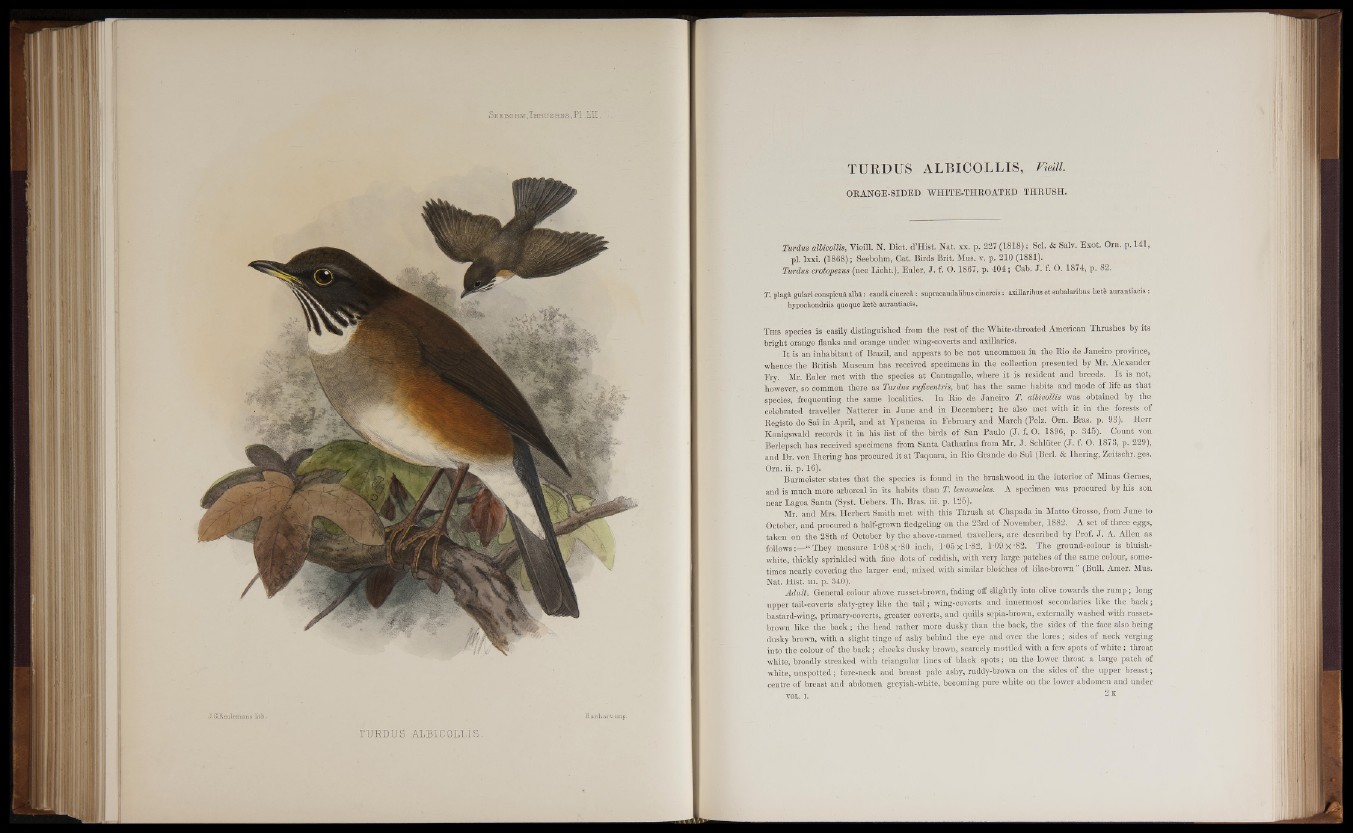
J . Gt^Keulemans libji.
lUKDTJS 'ALBIC 0 L 1 ÌS
H a n K a r b imp.
Turdus albicollis, Vieffl. N. Diet. d’Hist. Nat. xx. p. 227 (1818) ; Sol. & Salv, Exot. Orn. p. 141,
pi. lxxi. (1868) ; Seebohm, Cat. Birds Brit. Mus. v. p. 210 (1881).
Turdus crotopezus (nec Licbt.), Euler, 1. f. O.J.867, p. 404; Cab. J. f. O. 1874, p. 82.
T. plagà gulari conspicuà albà : caudà cinerei : supracaudalibus cinerei« : axillaribus et subalaribus bete aurantiaeis :
hypochondriis quoque lsetè aurantiaeis.
T his species is easily distinguished from the rest of the White-throated American Thrushes by its
bright orange flanks and orange under wing-coverts and axillaries.
It is an inhabitant of Brazil, and appears to be not uncommon in thè Rio de Janeiro province,
whence the British Museum has received specimens in the collection presented by Mr. Alexander
Fry. Mr. Euler met with the species at Cantagallo, where it is resident and breeds. It is not,
however, so common there as Turdus rufiventris, but has the same habits and mode of life as that
species, frequenting the same localities. In Rio de Janeiro T. albicollis was obtained by the
. celebrated- traveller Natterer in June and in December ; he also met with it in the forests of
Registo do Sai in April, and at Ypanema in February and March (Pelz. Orn. Bras. p. 98). Herr
Konigswald records it in his list of the birds of San Paulo (J. f. O. 1896, p. 345). Count von
Berlepsch has received specimens from Santa Catharina from Mr. J. Schliiter (J. f. 0 . 1873, p. 229),
and Dr. von Ihering has procured it at Taquara, in Rio Grande do Sul (Beri. & Ihering, Zeitschr. ges.
Orn. ii. p. 16).
Burmeister states that the species is found in the brushwood in the interior of Minas Geraes,
and is much more arboreal in its habits than T. leucomelas. A specimen was procured by his son
near Lagoa Santa (Syst. Uebers. Th. Bras. iii. p. 125).
Mr. and Mrs. Herbert Smith met with this Thrush at Chapada in Matto Grosso, from June to
October, and procured a half-grown fledgeling on the 23rd of November, 1882. A set of three eggs,
taken on the 28th of October by the above-named travellers, are described by Prof. J. A. Allen as
follows :—“ They measure 1-08 X '80 inch, l-0 5 x l'S 2 , 1 0 9X '82. The ground-colour is bluish-
white, thickly sprinkled with fine dots of reddish, with very large patches of the same colour, sometimes
nearly covering the larger end, mixed with similar blotches of lilac-brown ” (Bull. Amer. Mus.
Nat. Hist. iii. p. 340).
Adult. General colour above russet-brown, fading off slightly into olive towards the rump ; long
upper tail-coverts slaty-grey like the tail ; wing-coverts and innermost secondaries like the back ;
bastard-wing, primaxy-coverts, greater coverts, and quills sepia-brown, externally washed with russet-
brown like the back ; the head rather more dusky than the back, the sides of the face also being
dusky brown, with a slight tinge'of ashy behind the eye and over the lores ; sides of .neck verging
into the colour of the back ; cheeks dusky brown, scarcely mottled with a few spots of white ; throat
white, broadly streaked with triangular lines of black spots ; on the lower throat a large patch of
white, unspotted ; fore-neck and breast pale ashy, ruddy-brown on the sides of the upper breast ;
centre of breast and abdomen greyish-white, becoming pure white on the lower abdomen and under